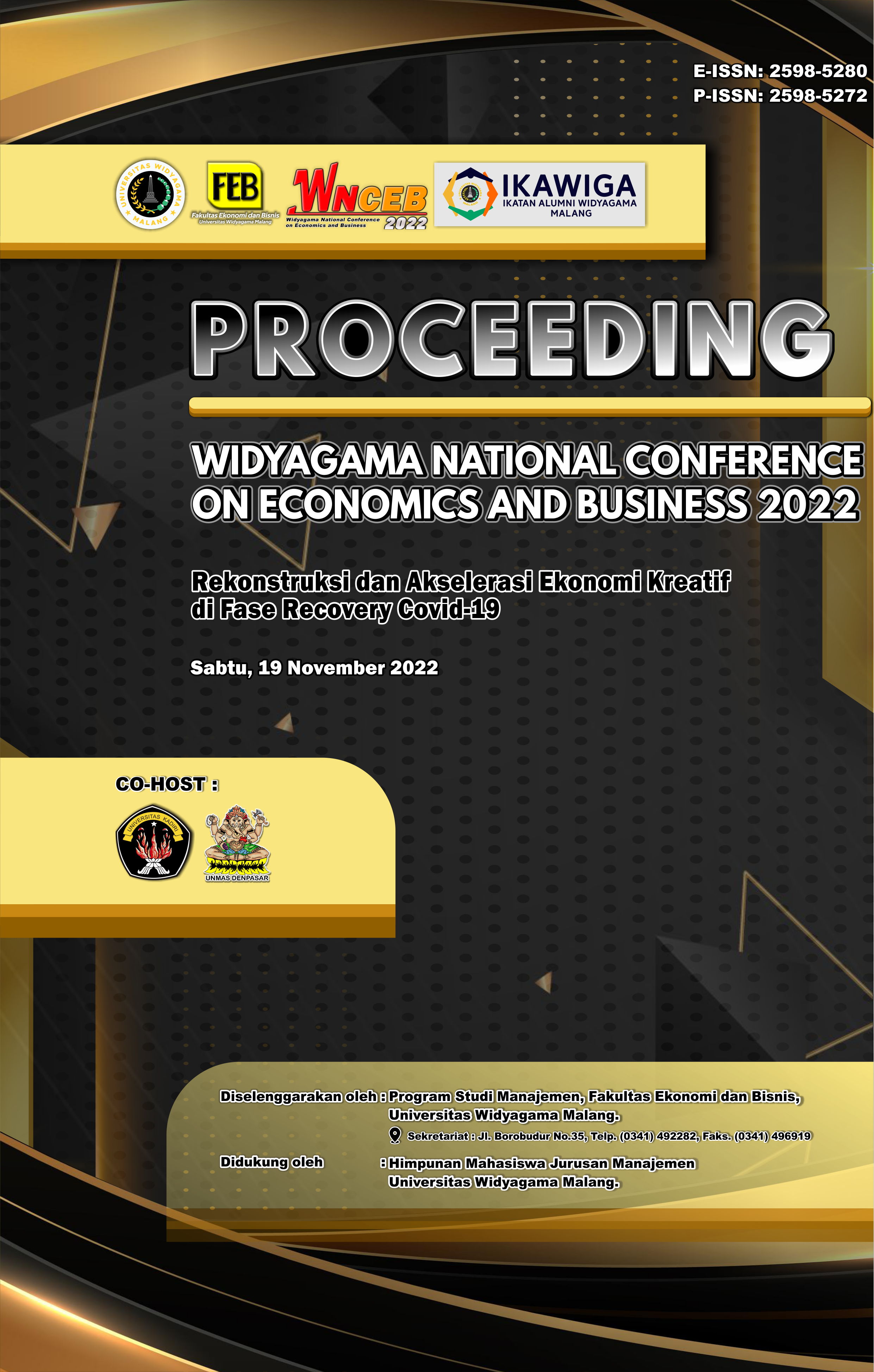Analisis Faktor Pengambilan Keputusan Konsumen di Kota Kediri Terhadap Produk Asuransi Pendidikan Anak
DOI:
https://doi.org/10.31328/wnceb.v3i1.4207Abstract
Abstrak Customer centric merupakan penerapan dari Customer Relationship Management (CRM)sebagai solusi khusus untuk penerapan pendekatan strategis yang berkaitan dengan menciptakan nilai produk atau layanan yang lebih baikmelalui pengembangan hubungan yang sesuai dengan pelanggan. Karena itu,implementasi proses CRM berpotensi untuk meningkatkan kinerja perusahaan secara signifikan pada tahap hubungan dengan pelanggan. Tujuan dari penelitian ini adalah untuk mengetahui faktor-faktor yang dipertimbangkan orang tua sebagai pengambil keputusan dalam penentuan suatu produk asuransi pendidikananak yang tepatdan menganalisis strategi customer centric yang tepat dalam memposisikan sebagai produk pilihan pertama di antara produk sejenis di perusahaan lain. Penelitian ini merupakan penelitian kuantitatif. Pengambilan sampel menggunakan metode Purposive Sampling, sedangkanmetode analisis yang digunakan adalah analisis faktor. Hasil penelitian menunjukan bahwa faktor – faktor yang menjadi prioritas pertimbangan orang tua dalam memilih produk asuransi pendidikan anak adalah: 1). Persepsi dan harapan konsumen dalam memilih produk asuransi pendidikan anak, 2). Kemudahan dan efektivitas prosedur transaksi produk asuransipendidikan anak, 3). Keunggulan / fitur dari produk asuransi pendidikan anak. Kata Kunci: Customer centric, Customer Relationship Management, asuransi pendidikan anak.Abstract Customer centric is the application of Customer Relationship Management (CRM), which is a process that together will bring a variety of information about customers, sales, marketing effectiveness, responsiveness and market trends, as an effort to change customer behavior habits and strengthen bonds between customers and company. The purpose of this study is to determine the factors that parents consider as decision makers in determining an appropriate child education insurance product and to analyze the right customer centric strategy in positioning it as the first choice product among similar products in other companies. This research is a quantitative research. Sampling using purposive sampling method, while the method of analysis used is factor analysis. The results showed that the priority factors for consideration of parents in choosing child education insurance products are: 1). Perceptions and expectations of consumers in choosing child education insurance products, 2). Ease and effectiveness of child education insurance product transaction procedures, 3). Advantages / features of child education insurance products. Keywords: Customer centric, Customer Relationship Management, products, savingsReferences
Anderson, T.W.2003. An Introduction Multivariate to Statistical Analysis Edition. New Jersey :John Wiley &Sons Inc.
PT. Bank Negara Indonesia ( Persero ) Tbk, 2008 – 2010, Annual Report BNI, Jakarta.
Boom Bitner .Seven Piece Extended Marketing Mix-Value Based Management.Net
Burhan, Bungin., 2005. Metodologi Penelitian Kuantitatif. Jakarta : Penerbit Kencana.
Coulter, Mary K, and Stephen P Robbins..2002, Management : Prentice Hall
Deck, Srewart.2001.CIO Magazine
Dalla Pozza, I., Goetz, O. and Sahut, J. M. (2018) ‘Implementation effects in the relationship between CRM and its performance’, Journal of Business Research, 89(June 2017), pp. 391–403. doi: 10.1016/j.jbusres.2018.02.004.
Dou, X. et al. (2019) ‘Outcomes of entrepreneurship education in China: A customer experience management perspective’, Journal of Business Research, 103(February), pp. 338–347. doi: 10.1016/j.jbusres.2019.01.058.
Foltean, F. S., Trif, S. M. and Tuleu, D. L. (2019) ‘Customer relationship management capabilities and social media technology use: Consequences on firm performance’, Journal of Business Research, 104(October), pp. 563–575. doi: 10.1016/j.jbusres.2018.10.047.
Ghalib, A.K. 2004. “Systemic knowledge management: Developing a model for managing organisational assets for strategic and sustainable competitive advantageâ€, Journal of Knowledge Management Practice.
Hair, J.F, Malhotra.1995.Multivariate Data Analysis.Fourth Edition. New Jersey: Prentice Hall Inc.
Jay R Galbraith, 2005, Designing The Customer – Centric organization A Guide To strategy, structure, and Process, Jossey Bass Business and Management Series.
Jaziri, D. (2019) ‘The advent of customer experiential knowledge management approach (CEKM): The integration of offline & online experiential knowledge’, Journal of Business Research, 94(May), pp. 241–256. doi: 10.1016/j.jbusres.2018.05.029.
Juwandi, Hendy Irawan. 2004. KepuasanPelayanan Jasa. Erlangga. Jakarta
Lee, L. W. Y. et al. (2018) ‘Managing customer relationships in the emerging markets – guanxi as a driver of Chinese customer loyalty’, Journal of Business Research, 86(October 2016), pp. 356–365. doi: 10.1016/j.jbusres.2017.07.017
Lovelock, Christopher & Wright, Lauren, 2002, Principles of Service Marketing and Management, Second Edition , Pearson Education, New Jersey.
Malhotra.1998. Marketing Research, Fourth Edition, New Jersey: Prentice Hall Inc.
Maholtra, Naresh K., 1999. Marketing Research : An Applied Orientation, 3rd edition, Prentice Hall, Inc., New Jesrey.
Nawawi, Hadari .1987.Metodologi Bidang Sosial. Yogyakarta : Gajah Mada University Press.
Nazir.1998. Metode Penelitian : Bumi Aksara Jakarta
Oswald A. Mascarenhas, Ram Kesavan, Michael Bernacchi, 2011, Keterlibatan rantai Pelanggan untuk meningkatkan kepuasan konsumen. 13 Januari 2011.
Prudentfamily.wordpress.com
Porter, Michael E., 1998, Competitive Strategy: Techniques for analyzing Industries and competitor, The Free Press, New York.
Robert Shaw.2001, Customer Relationship Management : Freedownload 15/ppt/robert-shaw
Rahayu, Sri, SPSS versi 12.00 dalam riset pemasaran, Alfabeta.
Rigby, Darrell K.; Frederick F. Reichheld, Phil Schefter. 2002. Avoid the four perils of CRM. Harvard Business Review80 (2): 101–109.
Santosa, Singgih, 2000, Riset Pemasaran, Elex Media Komputindo, Gramedia Pustaka Utama, Jakarta
Selmi, N. and Chaney, D. (2018) ‘A measure of revenue management orientation and its mediating role in the relationship between market orientation and performance’, Journal of Business Research, 89(April), pp. 99–109. doi: 10.1016/j.jbusres.2018.04.008.
Singarimbun, Masri dan Soffian Effendi. 1987. Metode Penelitian Survai. Yogyakarta : LP3ES
Sugiyono, 2004, Memahami Penelitian kuantitatof Kualitatif dan R&D, Penerbit
Alfabeta, Bandung
Sumardi, Snowerdi. 2005 . Analisis Persepsi Atas Faktor-faktor yang Berpengaruh Terhadap Penerapan Total Productive Maintenance di Pabrik Personal Care Rungkut PT. Unilever Indonesia Tbk.
Stanton, William J.1978.Fundamentals of Marketing.McGraw Hill
Thompson Jr. Arthur A. 2007, Crafting and Executing Strategy : The Quest for Competitive Advantage : StricklandIII, A.J., Gamble, John E.
Tjiptono Fandy.2005.Brand Management & Strategy: Penerbit Yogyakarta.Andi
Umar Husien 2010, Desain Penelitian Manajemen Strategik, Rajawali Pers, Jakarta
Yin, R. K.,. 1989, Case Study Research Design and Methods, Penerbit SagePublications Inc., London.
Wang, Z. and Kim, H. G. (2017) ‘Can Social Media Marketing Improve Customer Relationship Capabilities and Firm Performance? Dynamic Capability Perspective’, Journal of Interactive Marketing, 39, pp. 15–26. doi: 10.1016/j.intmar.2017.02.004.
www.Jasaraharja-Putera.co.id
Zainuddin, Muhamad. 1998. Metode Penelitian. Surabaya

